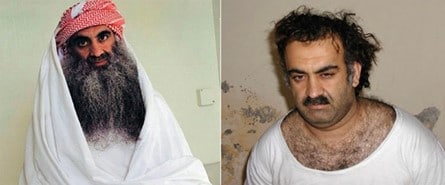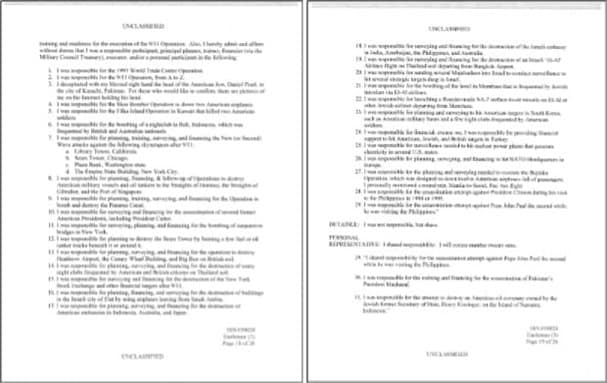Introduction
On this day 23 years ago, Al-Qaeda carried out wide-ranging attacks on U.S. soil, with 19 operatives hijacking four passenger airliners and flying two of them into the World Trade Center and one into the Pentagon, while the fourth crashed into a field in Pennsylvania after passengers fought back. It is thought that the hijackers had meant to attack the Capitol in Washington, D.C. In total, 2,977 were killed. Additionally, 441 New York first responders were killed.[1] For this 23rd anniversary, we are republishing a newly edited version of an analysis by MEMRI President and Founder Yigal Carmon, originally published on August 5, 2024.
It should be emphasized that while 15 of the 19 perpetrators were Saudis acting as individual members of Al-Qaeda, 9/11 mastermind Khalid Sheikh Mohammad was, in the period prior to the attacks, an employee of the State of Qatar and enjoyed the safe haven that it granted him. During his time as an employee of the Qatari Ministry of Electricity and Water, he engaged in terrorist activities such as attempts to assassinate Pope John Paul II during his visit to Manila and an attempt to down civilian airliners over the Pacific (the Bojinka plot), as he was under the patronage of Qatari Minister of Awkaf (Islamic Endowments) Abdallah bin Khaled Aal Thani of the Qatari ruling family.
The Rescinded U.S. Plea Bargain With 9/11 Mastermind Khaled Sheikh Mohammad And His Responsibility For The Attacks
The U.S.'s plea bargain with alleged 9/11 mastermind Khaled Sheikh Mohammad (KSM) would have prevented the full exposure of Qatar's role and responsibility in the attack.

The plea bargain, which was rescinded by U.S. Secretary of Defense Lloyd Austin, brought to light new and old documents about KSM's role in terrorist attacks against the U.S. and other countries while working as an employee of the state of Qatar. The documents also reveal that Qatar facilitated KSM's activities and his escape from arrest by the FBI.
When the FBI came to Doha in 1996 to arrest KSM (see his confession below), the only ones reportedly to be informed of this, in confidentiality, was the Qatari emir and the palace. Within hours, KSM had disappeared (see page 91 of the 9/11 Commission Report, on KSM's escape from Qatar).

Khalid Sheikh Mohammad
KSM's escape from Qatar was also revealed by Richard A. Clarke, counterterrorism advisor to Presidents Bill Clinton and George H. W. Bush, in his 2004 book Against All Enemies: Inside America's War on Terror, pages 152-153.
Richard A. Clarke (source: prhspeakers.com/speaker/richard-a-clarke); cover of his book
In the book, Clarke wrote that a report had stated that KSM learned about the U.S. plan to capture him: "We were, of course, outraged at Qatari security and assumed the leak came from within the palace." One report, Clarke said, contended that KSM had "fled the country on a passport provided by the [Qatari] Ministry of Awkaf [Islamic Endowments]." That government ministry was headed by Abdullah bin Khalid Aal-Thani, a member of the Qatari ruling family.
Pages 152-153 of Richard Clarke's Against All Enemies: Inside America's War on Terror.
The story was told in much the same way in Richard Miniter's 2011 book Mastermind: The Many Faces of the 9/11 Architect, Khalid Shaikh Mohammad: Minister of Awkaf Abdullah bin Khalid Aal Thani had "agreed to give KSM a no-show job at the Ministry of Electricity and Water and a government-sponsored apartment. Until 1996, this Qatari apartment and salary would be KSM's safe haven and his lifeline as he traveled the world."[2]
Cover and page 63 of Richard Miniter's book Mastermind: The Many Faces of the 9/11 Architect, Khalid Shaikh Mohammad.
Miniter writes, "By October 1995, KSM was seemingly cornered. The CIA and the FBI had tracked KSM to an apartment building in Qatar." With a valid extradition order, the FBI agents raced over to his apartment. It was empty... How had he gotten away? Qatar's minister of religious affairs [Minister of Awkaf Abdullah bin Khalid Aal Thani] had tipped off KSM and provided him and a travelling companion with false passports, according to Robert Baer, a former CIA official. Baer, who at the time was a CIA case officer working in the region, said that Hamid bin Jassim bin Hamad, a disgruntled member of the Kingdom of Qatar’s ruling family, had told him about the arrangement."[3]
Pages 104-105 of Richard Miniter's book Mastermind: The Many Faces of the 9/11 Architect, Khalid Shaikh Mohammad.
Baer had also, according to Miniter, told Daniel Pearl, the Wall Street Journal's Southeast Asia bureau chief,[4] that "from 1992 to 1996 KSM had a no-show job with the government of Qatar and that that government had hampered American efforts to arrest KSM there in 1996."[5]
Pages 136-137 of Richard Miniter's book Mastermind: The Many Faces of the 9/11 Architect, Khalid Shaikh Mohammad.
The 2012 book The Hunt For KSM: Inside the Pursuit and Takedown of the Real 9/11 Mastermind, by Terry McDermott and Josh Meyer, provides further details. It says that the Minister of Awkaf, Abdullah bin Khalid Aal Thani, had arranged for a job for KSM as a project engineer in the Ministry of Electricity and Water. How much he worked at the job is uncertain, but what is clear is that he hadn't quit the fight. He established a small fundraising operation there, recruiting men throughout the Gulf to seek out individual donors, who were often found among the older, wealthier men at local mosques.
According to McDermott and Meyer, "it is hard to hide in a place like Doha, one of the world’s smallest capitals. Security officials there were aware of Mohammad's activities and allowed him to continue. 'We knew he was sort of in possession of money and sending it somewhere,' a U.S. official said."[6]
Pages 42-43 of The Hunt For KSM: Inside the Pursuit and Takedown of the Real 9/11 Mastermind, by Terry McDermott and Josh Meyer.
The authors go on to state that according to the 9/11 Commission, most, if not all, of KSM's travels and activities during this time appear to have been related to his interest in carrying out terrorist operations. Some of this was funded by Minister of Awkaf Abdullah bin Khalid Aal Thani.[7]
Pages 94-95 of The Hunt For KSM: Inside the Pursuit and Takedown of the Real 9/11 Mastermind, by Terry McDermott and Josh Meyer.
The Qataris, according to McDermott and Meyer, apparently didn't care, and seemed to be supportive of KSM's jihad. Then one day U.S. Ambassador to Qatar Patrick Theros returned to the embassy from one of many meetings with the Qataris, where FBI Special Agent Frank Pellegrino was waiting. Theros told him that the Qataris, who were supposed to be watching KSM, had "lost" him.
"How, an American official asked, do you lose somebody in Qatar? Theros said that by 'lost,' he meant that KSM had slipped out of the country. Pellegrino was less tactful. Looking at the ambassador, he said: 'You motherfucker...' Almost as an afterthought, he threw in, 'Sir'... At the White House, Richard Clarke demanded a postmortem from the CIA about how this could have happened..."[8]
Pages 106-107 of The Hunt For KSM: Inside the Pursuit and Takedown of the Real 9/11 Mastermind, by Terry McDermott and Josh Meyer.
Qatar's role in enabling KSM to escape arrest by the FBI (only to continue on to terrorist attacks like 9/11) constitutes a major political and criminal indictment of the government of Qatar.
Sources
This report references four sources besides the books by Richard Clark, Richard Miniter, and McDermott and Meyer:
-
The 9/11 Commission Report, which includes information about KSM's whereabouts and terrorist activities
-
The Department of Defense 15-page memorandum detailing KSM's time and activity in Qatar, "much of it in furtherance of terrorist activities"
-
A September 2021 BBC report on former FBI special agent Frank Pellegrino, and an April 2012 interview with Josh Meyer on C-SPAN, also confirming Qatar's role in aiding KSM (and also in a memorandum).
-
The New York Times publications of KSM's indictment for the 1993 World Trade Center bombing, and of KSM's confession.
KSM's Confession
Information about KSM's terrorist activities has been gradually released since the 1990s by the U.S. government. KSM's confession in Guantanamo appeared in U.S. media in 2007, when victims could still sue Qatar for compensation. Lately, more information has been revealed, following the U.S. government's decision (now rescinded) to cut a plea deal with him.
While KSM admitted to all of these crimes after highly controversial CIA "enhanced interrogation" techniques after being apprehended in 2003, he was already wanted (by the FBI and other agencies) long before then for multiple terrorist attacks. These included the 1993 World Trade Center bombing (for which he was indicted; following that, in early 1996, he fled to Pakistan from Qatar to avoid capture by U.S. authorities). It also included the Bojinka plot – the 1994 and 1995 airplane plots in the Philippines that were considered a dry run for 9/11, the plot to assassinate Pope John Paul II, and other crimes. In addition, there is further evidence of his involvement in other actions – such as 9/11 and the gruesome 2002 murder of journalist Daniel Pearl – independent of any confession derived from CIA interrogation. According to KSM's confession as published by the Pentagon, he is supposedly responsible for the following terrorist attacks that he planned, masterminded, or executed.

Pages 18 and 19 of KSM's confession (Source: Int.nyt.com/data/documenttools/78034-isn-10024-khalid-shaikh-mohammed-combatant/394f687ce3c5e017/full.pdf)
Khalid Sheikh Mohammad (KSM) was actively involved in terrorist activities and planning while residing in Qatar during the mid-1990s. According to the 9/11 Commission Report, he moved to Qatar at the request of the Qatari government. In Qatar, KSM worked for the Ministry of Electricity and Water.
Despite the existence of KSM's confession, and despite the information in all the above-mentioned documents about Qatar's role and complicity in his terrorist activities, no punitive measures against Qatar have been taken by consecutive U.S. administrations.[9]
Left to right: Former Qatari Emir Hamad Bin Khalifa Aal-Thani (source: Memri.org/reports/exchange-between-former-south-african-president-mbeki-and-qatar-confirms-veracity-raven); current Qatari Emir Sheikh Tamim bin Hamad Aal Thani (Memri.org/reports/qatar-funded-and-operated-international-union-muslim-scholars-iums-and-hamas-leaders-qatar)
* Yigal Carmon is Founder and President of MEMRI.
[1] Bbc.com/news/world-us-canada-57698668, August 1, 2024.
[2] Mastermind: The Many Faces of the 9/11 Architect, Khalid Shaikh Mohammad, Richard Miniter, 2011, p. 63.
[3] Mastermind: The Many Faces of the 9/11 Architect, Khalid Shaikh Mohammad, Richard Miniter, 2011, p. 105.
[4] KSM was directly involved in Pearl's 2002 kidnapping and murder. Reuters.com/article/us-pakistan-alqaeda-pearl-idUSTRE74M27020110523, May 23, 2011.
[5] Mastermind: The Many Faces of the 9/11 Architect, Khalid Shaikh Mohammad, Richard Miniter, 2011, p. 136.
[6] The Hunt For KSM: Inside the Pursuit and Takedown of the Real 9/11 Mastermind, Terry McDermott and Josh Meyer, 2012, pp. 43-44.
[7] The Hunt For KSM: Inside the Pursuit and Takedown of the Real 9/11 Mastermind, Terry McDermott and Josh Meyer, 2012, p. 94.
[8] The Hunt For KSM: Inside the Pursuit and Takedown of the Real 9/11 Mastermind, Terry McDermott and Josh Meyer, 2012, p. 107. Theros would later become an apologist for Qatar in the U.S. media.
[9] This is also despite the fact that Qatar is the world's leading state sponsor of Islamic terrorist organizations and movements. It continues to support a wide range of Sunni and Shi'ite terrorist movements – the Islamic State (ISIS), Al-Qaeda, Hamas, Hizbullah, the Houthis, the Taliban, Jabhat Al-Nusra, Hayat Tahrir Al-Sham, and Iran's Islamic Revolutionary Guard Corps (IRGC).





